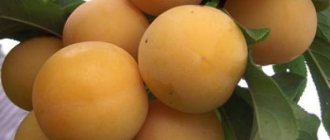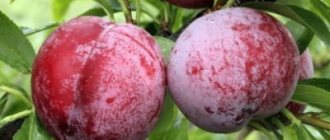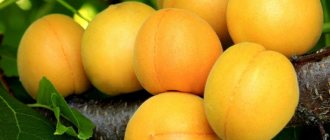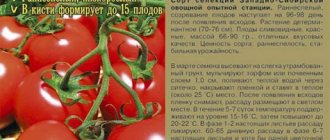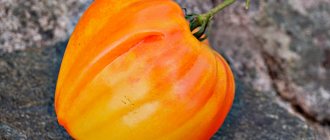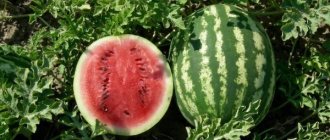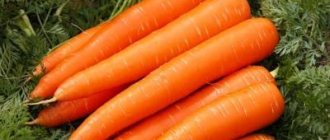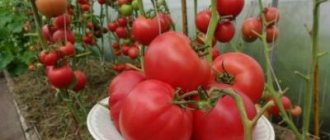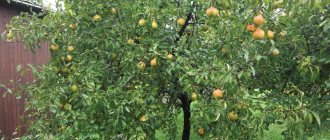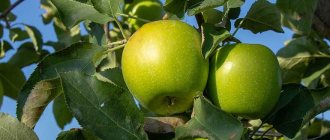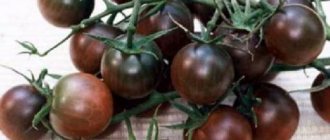Meet the decorative plum with red leaves
When choosing the first trees for their garden, most gardeners do not think about their appearance - the main role is played by tasty fruits. However, over time, the need for beauty arises - and then the decorative red-leaved plum comes to the rescue.
The leaves of the ornamental plum are not green, like most trees, but a rich red-violet color. Therefore, in the garden the plant acts as a bright accent. If a decorative plum with red leaves is chosen to be tall and spreading, then it stands out against the background of other trees, and if it is squat and short, it can border them or serve as a hedge.
Diseases and pests
Despite a good level of immunity to diseases and pests, it can still be susceptible to infection. The most common diseases of Pissardi plum are:
- Powdery mildew can be controlled with fungicides.
- Trunk necrosis can be detected at an early stage and all affected areas should be trimmed immediately.
There are also several parasites that can cause trouble. This variety of plum has leaf roller and fruit moth - chemicals (for example, bitoxybacillin and dendrobacillin) help against them, which should be sprayed on the tree and the area around it.
To avoid such problems, you should adhere to a number of simple rules:
- Trim trees on time.
- Collect and remove all affected parts of the tree rather than discarding them on site.
- Mulch the soil regularly and remove weeds.
- Fertilize and monitor the tree's immunity.
- Treat with insecticides.
To combat rodents such as hares and mice, you need to treat tree trunks with whitewash or rosin solution.
Line of hybrids “Russian plum”
Particularly popular in the middle zone are varieties of decorative Russian plums, obtained from crossing southern cherry plums with Ussuri or Chinese plums.
Scarlet Sails
The red-leaved plum of this variety is a tree up to 4 - 5 m in height, with a thinned but spreading crown, with large leaves of a rich red color. The plum, with red leaves and dark pink flowers, bears fruit in mid-August. Scarlet sails have a dark crimson color and average weight - each fruit weighs about 25 g.
Among the advantages of Scarlet Sails are high resistance to negative temperatures and drought, and low susceptibility to fungal diseases. The tree produces abundant harvests and bears fruit every year, but is classified as self-sterile. For Scarlet Sails, Chinese plum varieties Skoroplodnaya and Krasny Shar, as well as cherry plum Dynaya can become pollinators.
Lama
This decorative variety of Russian plum is distinguished by its small size - 1.3 - 2 m. The crown is round-flat, thick, the leaves are dark red throughout the summer period. Plum with pink flowers produces large raspberry fruits, each of which can weigh up to 40 g.
The red-leaved Lama variety was bred specifically for cultivation in the middle zone, so it can easily tolerate frosts down to -35 degrees. The tree's shoots are not afraid of light spring frosts; the variety has increased resistance to pests and diseases.
Llama is a self-fertile ornamental plum, so pollinators are required for high annual yields. Chinese plums and cherry plums with flowering in mid-May are well suited for this variety - for example, Vitba, Mara and Asaloda.
Early
Russian plum Early is a large tree up to 7 m in height with a rounded crown, large red leaves with serrated edges and a brown underside of the leaf. It has equally good resistance to frost, diseases and pests, and produces abundant harvests of dark red fruits.
The tree, like most plum varieties, is self-sterile, and therefore requires pollinators, for which cherry plums and Chinese plums with early flowering are ideal.
Nigra
Another red-leaved ornamental variety is Nigra, a low tree with an oval crown. Young leaves are ruby in color, while mature leaves are dark purple. The red-leaved plum blooms with pink flowers in late April or early May, even before the foliage appears on the branches. At the end of August it bears dark red round fruits.
It tolerates frosts below - 30 degrees and summer drought, does not break in the wind, and rarely suffers from diseases typical of fruit trees. The pollinator for the variety can be the Eurasia plum or the domestic Hungarian plum.
Features of care
Caring for Pissardi plum is largely the same as caring for similar deciduous plants.
Watering
Even taking into account the region of growth and a calm attitude towards drought, you should constantly and abundantly water the plum with water. It is advisable to do this every week from the second half of spring until the onset of autumn cold, pouring up to 60 liters of settled warm water onto the planted tree.
Top dressing
In the first year after planting, the plum tree does not need fertilizers, but already in the second year, adding fertilizing is a mandatory procedure and depending on the time of year, the fertilizing scheme will change:
- Autumn. Fertilize with humus, placing half a bucket and potassium fertilizers (potassium sulfate, potassium nitrate, potassium chloride, etc.) per square meter.
- Spring. Use sodium humate or nitrogen fertilizers, which speed up the growth process of annual growths.
- Fruiting period. Additional fertilizing from urea.
Wood processing and soil care
Always carefully care for the soil: loosen the soil so that the roots can receive oxygen, since the root system of the red-leaved plum is superficial and needs constant access to oxygen, remove weeds around the trunk. Perform the loosening procedure after the next irrigation. This procedure will help get rid of weeds that can harm the crop, especially in the first years.
Mulch the soil in the spring (to keep the root zone warm and active) and in the fall (to prevent the root system from freezing during extreme cold).
Tree pruning
Tree pruning should be done on a schedule in the spring. Use a formative type of pruning and a sanitary one - the second is especially important, since before the tree blooms there should no longer be any diseased or dry branches on it.
If thickets form, sanitary pruning will help remove them and ensure normal sunlight.
If the beginnings of diseases or the influence of parasites have been detected on the tree, pruning can be carried out at any time of the year, since the main goal of this event will be to save the tree.
Plum splayed
The spreading plum belongs to the category of red-leaved trees of tall and medium height with abundant and rapid fruiting - the first harvests are harvested from it already 2 years after planting. As a rule, plum varieties are intended for growing in warm climates.
Hesey
A bush variety of red-leaved plum called Hesei produces regular green foliage at first - but then the leaves turn purple, with pink or cream edges. The variety blooms with white flowers at the end of April, before the leaves bloom or simultaneously with it. Bears sweet and sour small red fruits.
The variety is characterized by low frost resistance and tolerates negative temperatures only up to – 28 degrees. Among the diseases that remain dangerous for him are black or holey spots. To obtain fruits, it is necessary to plant splayed plums with similar flowering periods nearby.
Pissardi
An Iranian plum variety up to 6 m tall with dark purple leaves and red shoots. Pissardi is an ornamental plum with pink flowers that blooms in early spring before the leaves bloom. In August it produces abundant pink fruits, provided that other varieties of spreading red-leaved plum have been planted nearby for pollination and bloom at the end of April.
The frost resistance of the Pissardi variety is not very high - from -20 to -28 degrees. But the tree is highly resistant to disease.
Cystene
This ornamental variety was obtained by breeding sand cherry and red-leaved Pissardi plum. The dwarf plant grows only up to 2 m, and at the same time it grows very slowly, so Cysten plum is often classified as a shrub with a columnar crown. The leaves are elongated, rounded and toothed, dark purple on the underside and red-violet on top.
The red-leaved Cystena blooms in early spring with white flowers with a red core, and in late summer it bears fruit - dark purple small drupes. If you plant other varieties of short red-leaved plums nearby, Cystena will delight you with abundant harvests.
The frost resistance of the variety is low, so it is not recommended to breed Cystena in cold regions. But the variety is quite resistant to diseases and pests.
Description of the variety
The appearance of this variety helps gardeners recognize it among other varieties without much effort. It is a member of the Rosaceae family. Let's consider its features.
Tree
Has a decorative appearance. It attracts attention due to the presence of a spreading crown, which gave it another name - splayed plum. Characterized by the following features:
- height - from 5 to 9 meters, but there are also giants, up to 12 meters high;
- dense, spreading crown;
- shoot color – red;
- the bark of the shoots is smooth and dark;
- the trunk is short, brown;
- Every year the shoots become larger by 20-25 cm;
- leaves are oval;
- leaf length 5-7 cm;
- alternate placement of leaves;
- leaf color is purple or red;
- color does not change during the growing season;
- leaf length – from 4 to 6 cm;
- pale pink buds appear in April.
Fruit
Pissardi plum fruits have the following characteristics:
- a bountiful harvest;
- fruit size – 3 cm;
- weight ranges from 20 to 30 grams;
- round in shape and similar to the cherry plum fruit;
- fruit color – dark cherry;
- taste – sour-tart;
- Inside there is a large oval-shaped bone.
Purple-leaved decorative plum: photo + description
The decorative purple-leaved plum is ideal for decorating the garden - a shrub reaching 1.5 in height, with elongated lanceolate leaves. At the very beginning, the foliage of the plum bush is dark red, then as it matures it can turn to a dark brown shade. The purple-leaved ornamental plum produces white or light pink flowers at the same time as its foliage appears, and bears a harvest of dark red fruit in late September.
It is best to plant plums in windless, sunny places, in well-drained, slightly alkaline or acidified soil. The shrub has high winter hardiness.
What are Pissardi's characteristics?
Gardeners choose Pissardi depending on their taste preferences and the main characteristics of the variety.
Edibility of fruits
Pissardi fruits are juicy drupes of a dark cherry color. They are edible, but not everyone will like them, since their taste is sour and tart. But even if it does not have the most outstanding taste, plums contain a huge amount of useful micro- and macroelements.
Flowering and pollination
The variety begins to bloom around April. The flowering period ends after about a month, when the tree is already covered with leaves. At this time, the flowers become soft pink and bloom on a peduncle of the same shade.
When the flowering period comes to an end, the flowers become brown, the stamens have a bright crimson hue, and the diameter of the flower is 2.5 cm. Plum flowers are considered very beautiful, and they also smell very pleasant.
Plums begin to ripen in August and can stay on tree branches until October. The life cycle of Pissardi depends on the region of growth and can last from 35 to 90 years.
Pissardi needs pollinating trees to produce a bountiful harvest. Suitable for these purposes:
- Chinese plum;
- other varieties of Pissardi.
Drought and frost resistance
Plum gets along well in temperate climates - the tree can easily cope with drought and heat, and does not like excessive moisture, so it is not recommended to plant in places close to water bodies.
It has low frost resistance; extended and too severe frosts are not for it, since they are difficult and painful for the tree, so plant the plum in warm and sunny areas.
Transportability and storage
If you pick the fruits 4-5 days before final ripening, they will be able to better survive transportation. If plums are needed for processing into compotes or jam, then you should wait until they are fully ripe.
Red-leaved plum variety "Hollywood"
One of the most popular red-leaved varieties is Hollywood. The plum tree reaches several meters in height and is distinguished by a spreading, sparse crown formed by dark red shoots and red leaves. Hollywood blooms with white flowers. It is not only the appearance of the plant that is attractive, which can be appreciated from the photo of a plum with red leaves. The variety also bears purple-red tasty fruits in mid-August.
Hollywood enters the harvest period 5 years after planting and produces juicy and sweet fruits. The best pollinators for a self-sterile variety will be the collective farm Renklod and the Mirnaya plum.
Important! The Hollywood variety has good winter hardiness, tolerates lack of moisture well and is not susceptible to fungal diseases.
Pros and cons of the variety
Plum, although it does not have amazing taste, nevertheless has a number of advantages:
- fruits hang on the branches for a long time;
- unpretentious and unpretentious tree to care for;
- foliage, inflorescences and fruits have an excellent decorative appearance;
- is able to adapt to unfavorable conditions, which makes it possible to grow this variety within the city;
- It is resistant to a large number of fungal infections and other diseases.
And a number of disadvantages:
- not the most delicious fruits;
- low level of frost resistance;
- the tree does not tolerate gusty winds and drafts;
- There should be no other plants nearby, since the plum does not accept proximity.
The nuances of growing ornamental plums
Plum varieties with burgundy leaves can be quite different from each other - it is quite difficult to formulate uniform rules of care for them. But general nuances still exist.
- Decorative plums do not like overly waterlogged soil; it is better to plant them in soil with a neutral acidity level.
- Before planting in the seedling hole, it is necessary to add organic fertilizers - humus and superphosphate, which will nourish the plant in the first 3 years of life.
- After entering the harvest season, red-leaved plums are regularly fed with mineral fertilizers and organic matter. In the spring it is necessary to apply nitrogen fertilizers, in the summer - a solution of mullein and potassium. In autumn, the soil around trees and shrubs is dug up and also flavored with humus.
- Decorative plums should be watered as needed - the soil should not be allowed to dry out. Usually, once every 1–2 months, with moderate precipitation, 4–5 buckets of water are added under the roots.
Decorative plum with red leaves necessarily needs pruning, which is carried out annually. Red-leaved trees and especially shrubs tolerate pruning well; their crowns are given a round, sparse or vase-like shape.
Attention! Decorative red-leaved plums also require sanitary pruning - timely removal of all dry and weakened parts. Otherwise, the plant may suffer from diseases and pests.
Preparation and planting
Since Pissardi is an unpretentious variety, you don’t need to put in a lot of effort for its planting and subsequent care - simple basics are enough, thanks to which high-quality growth and a rich, stable harvest will be ensured.
We recommend that you additionally read the article on how to plant and grow plum trees.
Place and dates
Pissardi is a very sun- and heat-loving plant. Plant trees on the south side of the garden, away from strong winds and drafts, and so that other trees do not cover this plum tree. Be sure to measure the groundwater level - its depth should not exceed 1.5 meters to the bottom of the hole, since Pissardi does not like excess moisture. If this cannot be avoided, then use expanded clay drainage.
Plant trees before the buds swell in the spring, this will give the plant a chance to take root in the soil before the onset of cold weather. But this does not mean that autumn is not suitable for planting. September is considered the best option, since the cuttings will also have time to adapt to environmental conditions.
Neighborhood of cultures
This variety is not able to grow too close to other plants, as it loves solitude and space around itself. Make sure that the tree is not surrounded by unfriendly neighbors. Only at a distance of 5 meters you can plant the following crops:
- berry bushes;
- evergreen tree options;
- apple trees
You cannot plant next to:
- red leaf raspberries;
- pear.
Selection and preparation of seedlings
Planting material of the variety is divided into self-rooted and grafted. When choosing between open and closed roots, choose the first option, as they are more developed and can take root and grow better.
Despite the fact that even large-sized ones (seedlings 5 years old and older) can be sold in nurseries, you should not rush to purchase them in the hope that this way you can get a harvest faster. A common occurrence is cut off roots in seedlings of this age, which indicates that they will take root for another couple of years and during this time younger seedlings will be able to catch up with them and overtake them in development.
When choosing a seedling, consider the following points:
- Pay attention to the level of development of the root system. Plums that are 1-2 years old should have 3 to 5 main roots 25-30 cm long.
- The best choice of planting material occurs in the fall. If the seedlings were purchased in early autumn, then plant them immediately, without delaying until spring, and if in late autumn, then dig them in.
Boarding instructions
Planting a seedling does not require large investments or resources. You only need to have a standard set of tools and materials:
- shovel for holes;
- soil disintegrant;
- fertilizers;
- water;
- soft rope;
- a peg to tie up the cutting.
The landing process occurs in the following order:
- Prepare a hole measuring 50x70 cm (do this 2 weeks before planting), fill it with a fertile layer of soil that has already been mixed with compost and leave it in this state for 2 weeks.
- Install the landing stake.
- Place the seedling on the north side of the stake.
- Straighten the roots and place them in the hole so that the root collar is at a distance of 3-5 cm from the ground level, after which the roots can be covered with soil.
- Compact the ground.
- After completing the planting process, tie the plum to a stake, mulch the ground and water well.
